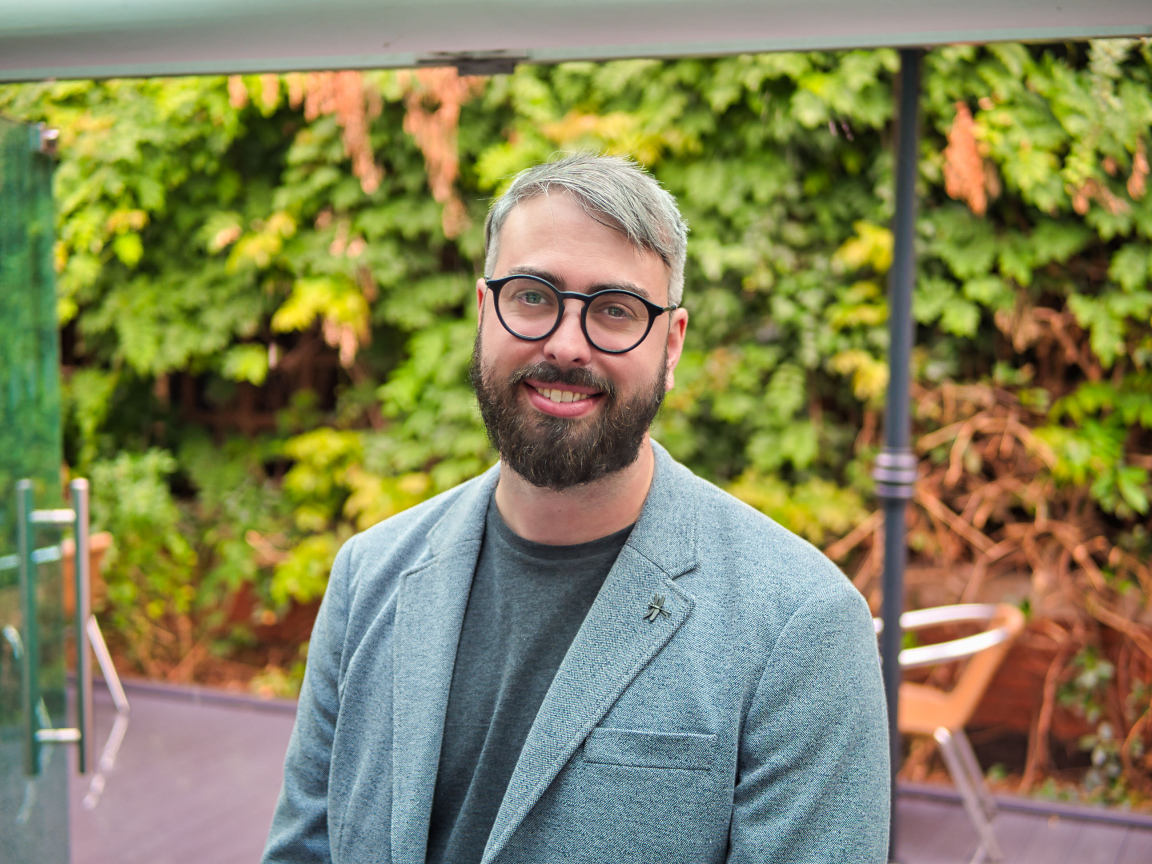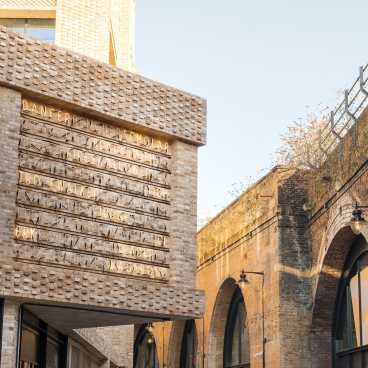Matt Redding, associate at Gensler: Debunking ESG for a better built environment.

Do you know your 'E' from your 'S' from your 'G'? If the answer is "no" then it's highly unlikely you're alone. The acronym that appeared to pop out of nowhere now plays a major role in the conversations surrounding sustainability in the built environment.
With this in mind, we were keen to ask an expert to explain in no uncertain terms what ESG really means, whether all elements are as important as one another, and how it applies to different built environment businesses. And who better to ask than Matt Redding, associate at Gensler? An integrated architecture, design, planning, and consulting firm with over 6k professionals networked across 52+ global offices.
We recently exhibited our From The Ground Up installation at Gensler's European headquarters in London, and have since continued the conversation around the ways we can collectively build a more regenerative future for all.
Read on for Matt's straight-forward guide to understanding ESG.
What is ESG?
"ESG stands for Environmental, Social, and Governance and it is the standard used to look at a company’s environmental impact (Environmental), its relationships in the area it operates in (Social), and its internal controls and leadership (Governance).
"This criteria is then screened by potential investors to understand if the company is a good investment. What’s really critical to understand is that it is not Corporate Social Responsibility (CSR); The key difference between the two is that CSR is a business model used by individual companies, whereas ESG is the criteria used by investors to determine a company’s worth."
What does it mean to the built environment?
"When a building requires investment, somebody has to ultimately pay for it. To determine if a project is going to be worth investing in, the set criteria of ESG needs to be considered. Whilst a number of the requirements are at a company level – executive pay, shareholder rights, audits (governance) – a building’s potential greenhouse gas emissions (GHG) need to be considered as part of the Environmental aspect. If you’re already scratching your head, don’t worry, it is confusing.
"Put simply, if a company doesn’t review the impact a development will have, then they won’t get the funding they need to build the building. This is significant to a lot of companies as it ultimately hits them in an area that every good business understands: money."
How can architects and designers help bring ESG to life?
"Firstly, make sure you’re not confusing ESG with CSR. Secondly, understanding what our clients are looking to achieve. Rather than ESG being seen as a scary subject, it should be a practical conversation about investment and understanding what a client needs to achieve to gain funding.
"Architects and designers are great at supplying clients with good quality information, but the key is to make sure the information satisfies the funding requirements. Good communication is paramount to the regenerative growth that we all want. We will stop building ‘less bad’ and start building in a way that is impactfully better for our future."
I’d replace the term sustainable with regenerative. Sustainable implies we are doing just enough good to cancel out the bad and sustain ourselves.
What does your role entail?
"As an architecture firm, ESG can be brought to the forefront of the conversation with elements of ‘E’ and ‘S’ when it comes to wellbeing and inclusivity. We also look at greenhouse gas emissions, and low impact, high durability materials. All of this is to help to attain our clients’ ESG goals – ultimately the value that we are adding as the designer is ensuring that their assets continue to have value long after we’ve gone. That is, the longevity of the design is testament to the asset’s value. "
Gensler is a huge advocate of ESG for securing a more sustainable future. Can you tell us more about how what your team does fits with the work of the wider company? And how you work with clients on a day-to-day basis?
"We have to work closely with all design teams to ensure that the expertise is shared throughout the project. Not everyone is trained in specific areas, and so take a holistic approach by pulling in different talent from across the entire firm. In doing that, we get a clearer understanding of what can be achieved, and a much higher quality result in the end.
"Working with clients, ESG is such an incredibly broad subject with numerous accreditations that can be achieved to showcase positive ESG-related efforts. We have to collaborate as an industry to help our clients achieve their aims and goals and report on whether or not they are achieving them. It’s all about reliable, authentic, measurable data and that can only be gained through having stakeholders communicating on both the client side and the Gensler side. It is a step-by-step process, and we can only make change together."
Is every aspect of ESG applicable to all businesses?
"Yes. The only limiting factor is how much of that category is relevant to each business. Every business should have E, S, and G involved in it; they just might be weighted differently on a case-by-case basis."
What are the three key things architects and designers can do to assist their clients in securing a more sustainable future?
"To assist clients in securing a more sustainable future, we need to keep educating ourselves and stay up to date. This is a market that is evolving incredibly rapidly. The old ways of thinking are drastically changing, and I think everyone has realised that ‘business as usual’ is not going to be good enough, even in the next 3-4 years, as we’re always looking further ahead.
"By 2026, a business is going to be judged on whether they are ready for 2030, when all our ESG commitments will be tested. Most buildings that are being designed now will be built by 2026, at which point there is no room thereafter for any error in meeting requirements for projects built over the following four years. If we aren’t learning our mistakes and rectifying them now, we’ll be out of time.
"For me, I’d replace the term sustainable with regenerative. Sustainable implies we are doing just enough good to cancel out the bad and sustain ourselves. It’s a plateau. We need to pave the way for a regenerative future, with the mindset of ‘my good is cancelling out my bad and adding something better.’"
What trends are supporting better ESG? I.e. biomaterials for example?
"The reality is that any product that sequesters carbon is key. If you can lock a large amount of carbon in your building, and your building then stays up for a number of years, then that’s ideal. If you’re building with materials that take too much carbon to produce and don't sequester, then you’re having a negative impact.
"Biobased materials are a way for us to create a solution to our own problems. We are looking towards nature – our greatest ally – to learn how to be regenerative. The natural world has worked out a perfect cycle so that nothing is wasted. It shows us that in a healthy and diverse environment, you have resilience and sustainability. That’s why we’re seeing materials that have typically been chemical based turning to bio solutions.
"It’s not just biomaterials. We are also looking at things like diversity, which is also exampled in nature. It is diverse ecosystems that thrive. We need people from different cultures and backgrounds with a range of talents actively at the table. That’s something we pride ourselves on at Gensler, and no talent is inaccessible."
What is your team currently working on?
"We are working with a number of clients to establish their ESG goals, and to help turn existing ESG goals into practical solutions. Importantly, we’re working on ourselves too. We want the industry to change and so we must set our minimum requirements for the products that we use. Our Co-CEO Diane Hoskins has been very clear on that, and we’re looking into this very seriously. We have to draw the line somewhere and there are so many different criteria globally that differ that we need to just say, ‘as a minimum we need to do this’. Then we can make real change.
"We are also training talent within our business, to grow and educate our industry. No one should be left behind."
And what’s next for Gensler?
"It’s continual growth, through learning and bettering what we do. No one is perfect, but we want to strive for a more regenerative future, and we can only do that by continually reviewing, evaluating, and changing what we do now to make sure that the future for the generations to come will be as beautiful as our experience of the world."




